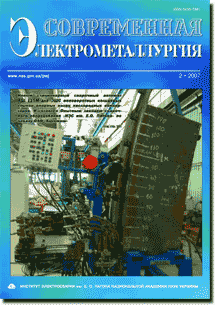

ELECTROSLAG TECHNOLOGY
Troyansky A.A., Ryabtsev A.D., Petrenko V.L., Medovar L.B., Dymnich A.Kh., Mastepan V.Yu. and Ratiev S.N. On new aproach to construction of the ESR automatic control system 2
On the basis of the melting nature analysis of consumable electrodes of small section under fluxes of different electric conductivity, the possibility is shown of «self-vibration» phenomena occurrence in electrodes in ESR.
Tsykulenko K.A. Certain aspects of deposited layer formation in portioned electroslag cladding with application of liquid additive metal 6
Peculiarities of the deposited layer formation in electroslag cladding by liquid metal in the current-conducting mould are considered. Influence of the portioned pouring conditions on quality of the joint zone and crystalline structure of the deposited layer (formation under certain conditions of the undulated or rectilinear joint zone, conditions of constant increase of the penetration depth or general lack of penetration, formation of drops in the deposited layer, and changes of the crystalline structure caused by the portioned pouring of the liquid additive material) is shown.
ELECTRON BEAM PROCESSES
Akhonin S.V., Milenin A.S. and Samofalov A.V. Modeling of evaporation processes of alloying elements from TiД6AlД4V alloy in EBCHM and portioned discharge 10
Mathematical model of evaporation of alloying elements in electron beam cold hearth melting (EBCHM) and portioned discharge of the metal for TiД6AlД4V titanium alloy is developed. Within the framework of the suggested model dependencies of chemical composition of the ingot being melted upon technological parameters of the process are obtained. Adequacy of the model is confirmed by the experimental data obtained as a result of melting of the TiД6AlД4V alloy ingots.
Yakovchuk K.Yu., Skryabinsky V.V., Marinsky A.G. and Didikin G.G. Hard erosion-resistant graded coatings deposited in vacuum 15
Possibilities of using electron beam technology and equipment for application of hard erosion-resistant graded coatings on components of state-of-the-art machinery are shown. Results of investigations of chemical composition, structure, and functional properties of hard erosion-resistant graded TiN- TiC-, and B4C-base coatings deposited from vapor phase on surface of steel and titanium alloys according to the single-stage technology are presented.
GENERAL PROBLEMS OF METALLURGY
Kurenkova V.V., Onoprienko E.V., Malashenko I.S., Grabin V.V., Belyavin A.F. and Chervyakova L.V. Mechanical properties and structure of brazed joints of JS26VI cast nickel alloy. Part 2 21
Interconnection of physical-chemical properties of the seam metal with microstructure of brazed joints of the JS26VI cast nickel alloy produced with application of complex brazing alloys, containing boron and silicon as depressants, is considered. Silicon was added in the form of a powder of the NS12 (NiД12 wt.% Si) commercial brazing alloy. The best results were achieved in case of introduction into the complex brazing alloy of 20 wt.% NS12. In this case brazed joints were characterized by strength at the level 670Д760 MPa, and their relative elongation achieved 13 % at room temperature.
Borisov Yu.S., Borisova A.L., Tunik A.Yu. and Murashov A.P. Physical-chemical processes in composite powder particles under conditions of plasma spraying 33
Results of investigation of composite powders produced by the SHS method and containing in its composition a metal component (Ni, NiAl, NiCrBSi) and inclusions of refractory compounds (titanium and chromium carbides, titanium silicide and aluminium oxide) are presented. Physical-chemical processes, occurring in particles of these composite powders in the course of their heating and movement in high-temperature gas flow, are investigated.
Tsykulenko K.A. Titanium. Problems of production. Prospects. Analytical Review. Part 2 39
Methods of production of titanium ingots with application of both consumable and non-consumable electrodes are considered. Main problems, occurring in production of titanium ingots, are shown. Advantages and shortcomings of different methods are noted.
ELECTROMETALLURGY OF STEEL AND FERROALLOYS
Saviuk A.N., Derevyanchenko I.V., Kucherenko O.L., Stovpchenko A.P., Projdak Yu.S., Kamkina L.V. and Grishchenko Yu.N. Mastering of production technology and investigation of quality of especially low-carbon rolled wire 48
Technology of especially low-carbon steel production in the arc steel furnace is mastered. Parameters of electric furnace intermediate product, degassing of which allows producing especially low-carbon steel, are experimentally substantiated. The determining factor is achievement of the optimal oxidization of the tapped metal for removal of carbon. Complex of investigations of the macro- and microstructure, degree of inhomogeneity and contamination with non-metal inclusions, and mechanical tests of the rolled wire showed that the structure and level of the properties create possibility for its drawing without intermediate annealing.
ENERGY AND RESOURCE SAVING
Tsybulkin G.A. On issue of dependence of the carbon granular material electric properties upon pressure and size of fractions 53
Analytical model, describing dependence of specific electric resistance of the electro-conducting granular materials upon pressure, is obtained. It is shown that electric conductivity of the granular material is invariant in relation to the size of its fractions.
Congratulate with jubilee 56
Developed at PWI 38
(You are viewing the simplified file contents)
